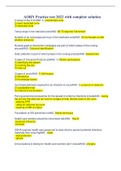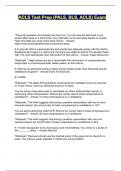Assignment One
Date: 29/09/2023
Contents:
Page 2 - 3: Learning Aim A1: Understand different views on the nature
of metal wellbeing and mental health (P1, M1, D1)
Page 4 - 10: Learning Aim A2: Factors that affect mental wellbeing and
mental health across the lifespan (P1, M1, D1)
Page 11: Learning Aim B1: Recognised mental ill-health conditions and
their symptoms according to current classification systems (P2, P3, M2,
D1)
1
,Learning Aim A1: Understand different views on the nature of mental
wellbeing and mental health
A.P1 – Explain the factors that influence mental wellbeing and mental health.
A.M1 – Analyse factors that influence mental wellbeing and mental health with reference
to a view on the nature of mental wellbeing and mental health.
AB.D1 - Evaluate the nature of mental health and wellbeing and the role of current
classification systems in improving the diagnosis of selected mental ill-health conditions
and their symptoms.
Introduction (P1):
Mental health is a wide topic that can be summarised as the way we “think, feel, and
behave.” (White, Felman, and Tee-Melegrito, 2022). According to the World Health
Organisation, “mental health is a state of mental well-being that enables people to cope with
the stresses of life, realise their abilities, learn well and work well and contribute to their
community.” As for mental wellbeing, it can be described as a combination of how we feel
and how we function (independence, relationship with others, etc.) (Paul Hamlyn Foundation,
2023) As time has gone on, our perception of mental health has changed drastically from
believing that interpreting ill mental health as a lack of faith or sign of demonic possession in
the medieval times and before the 1700s, to believing mental health to be a sickness that must
be cured (1800s-1900s). This “sickness” would be treated using surgery, heavy medication
and group therapy. In the present, mental health is interpreted as a scale that fluctuates
between highs and lows, with people receiving biopsychosocial care and specialised
treatment when their mental health I on the low end of the scale. (StudySmarter GmbH,
2023) Many accomplishments were made leading up to the modern day, including the
establishment of the NHS in 1948 to generalise the best health advice and treatment for free.
Mental Capital (P1, M1, D1):
2
, Mental capital refers to an individual's mastery of life skills when facing choices in
their life, such as their ability to think, learn, interact with others, etc. Mental capital can be
used as a measure of someone’s mental wellbeing as it can be used to assess the individual’s
abilities and thoughts, such as if the individual is having suicidal thoughts. (House of
Parliament, 2023) To achieve mental capital for the population, the Government can set
policies to provide for the people. For example, there are various awareness schemes to
promote good mental health and being which in turn promote mental capital, as well as
having policies to ensure the fair treatment of people, equal pay, resources provided through
food banks, etc. These are just to name a few legislations and schemes that promote mental
capital. However, there are challenges in achieving mental capital in modern times. One
example of this is the cost-of-living crisis which leaves people struggling to afford everyday
needs and wants, which affect their mental health negatively. By being unable to afford these,
the individual will find it hard to achieve a mastery of skills due to being deprived of
resources.
The government also has a role in ensuring mental capital is high among the population. For
mental capital to improve, they need the resources to build on their life skills as well as
sufficient time outside as they are spending inside in order to promote social interactions.
People would also need access to education facilities to learn and think well. The government
published started a project (The Foresight Project on Mental Capital and Wellbeing) on
mental capital in which they aimed to educate people on how encouraging and enabling
themselves can help to realise their potential through their lives will be crucial for the
country’s future prosperity and wellbeing. The project aims at children, adults, vulnerable
people, and others. It is specialised towards each group. For children, the government will
address issues starting from the womb, such as maternal stress for mothers and demoting
smoking while pregnant. Regarding the children, the project encourages speaking out about
learning disabilities like developmental dyslexia and development dyscalculia. In regard to
adolescence, the project demotes bad habits such as smoking and drinking. And in those
suffering from mental illness, the scheme looks to address its risk factors, like debt and late
diagnosis as well as medication. (Foresight Mental Capital and Wellbeing Project, 2008)
Preventing Mental Illness (P1, M1):
There are three types of prevention – primary, secondary and tertiary. Primary
prevention puts it focus on reducing a person’s chances of encountering situations that may
worsen their mental health. For example, campaigns may advice against alcohol and
smoking. It is good for promoting awareness for mental health as the prevention tactic looks
at promoting healthy habits into a person’s life to reduce the chances of developing a mental
illness. On the other hand, primary prevention may fail to show people ways to get help as it
puts focus on before a person’s mental health declines.
Secondary prevention looks at preventing a person’s mental health from worsening. An
example of this would include taking walks in the park or meditating to calm your mind.
Secondary prevention has both strengths and weaknesses; for example, it promotes mental
health in a way to bring awareness to the public. However, this method looks to prevent
mental health from worsening rather than helping people get better.
3












